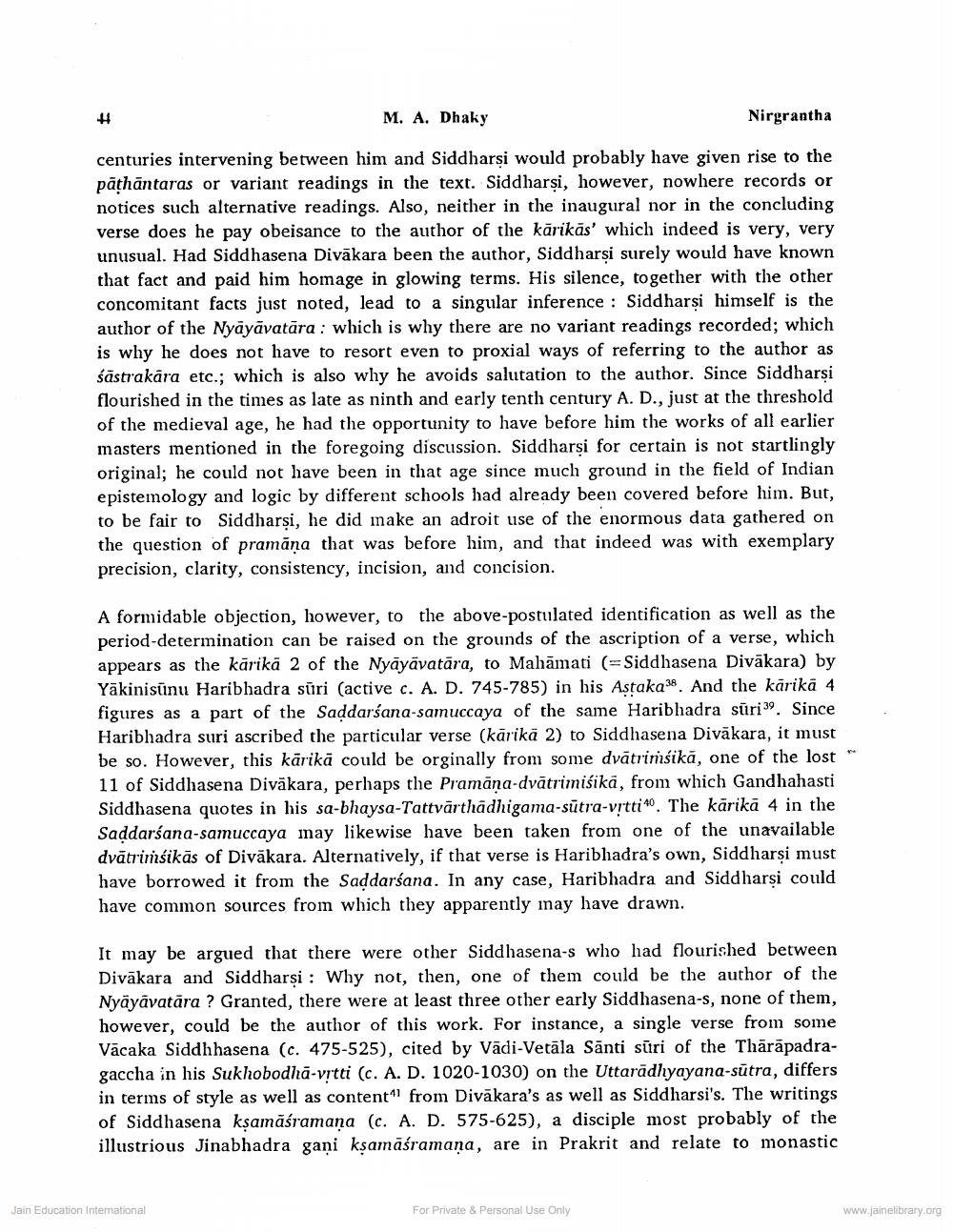________________
M. A. Dhaky
Nirgrantha
centuries intervening between him and Siddharși would probably have given rise to the pāthāntaras or variant readings in the text. Siddharşi, however, nowhere records or notices such alternative readings. Also, neither in the inaugural nor in the concluding verse does he pay obeisance to the author of the kārikās' which indeed is very, very unusual. Had Siddhasena Divakara been the author, Siddharşi surely would have known that fact and paid him homage in glowing terms. His silence, together with the other concomitant facts just noted, lead to a singular inference : Siddharşi himself is the author of the Nyāyāvatāra : which is why there are no variant readings recorded; which is why he does not have to resort even to proxial ways of referring to the author as śāstrakāra etc., which is also why he avoids salutation to the author. Since Siddharsi flourished in the times as late as ninth and early tenth century A. D., just at the threshold of the medieval age, he had the opportunity to have before him the works of all earlier masters mentioned in the foregoing discussion. Siddharşi for certain is not startlingly original; he could not have been in that age since much ground in the field of Indian epistemology and logic by different schools had already been covered before him. But, to be fair to Siddharși, he did make an adroit use of the enormous data gathered on the question of pramāņa that was before him, and that indeed was with exemplary precision, clarity, consistency, incision, and concision.
A formidable objection, however, to the above-postulated identification as well as the period-determination can be raised on the grounds of the ascription of a verse, which appears as the kārikā 2 of the Nyāyāvatāra, to Mahāmati (=Siddhasena Divakara) by Yakinisūnu Haribhadra sūri (active c. A. D. 745-785) in his Astaka 38. And the karikā 4 figures as a part of the Saddarśana-samuccaya of the same Haribhadra sūri. Since Haribhadra suri ascribed the particular verse (kärikä 2) to Siddhasena Divākara, it must be so. However, this kārikā could be orginally from some dvātrimsikā, one of the lost ** 11 of Siddhasena Divākara, perhaps the Pramāna-dvātrimisika, from which Gandhahasti Siddhasena quotes in his sa-bhaysa-Tattvārthādhigama-sūtra-vitti 40. The kārikā 4 in the Saddarśana-samuccaya may likewise have been taken from one of the unavailable dvātrimśikās of Diväkara. Alternatively, if that verse is Haribhadra's own, Siddharsi must have borrowed it from the Saddarśana. In any case, Haribhadra and Siddharși could have common sources from which they apparently may have drawn.
It may be argued that there were other Siddhasena-s who had flourished between Divākara and Siddharși : Why not, then, one of them could be the author of the Nyāyāvatāra ? Granted, there were at least three other early Siddhasena-s, none of them, however, could be the author of this work. For instance, a single verse from some Vācaka Siddhhasena (c. 475-525), cited by Vadi-Vetāla Santi sūri of the Thārāpadragaccha in his Sukhobodhā-vitti (c. A. D. 1020-1030) on the Uttarādhyayana-sútra, differs in terms of style as well as content from Divākara's as well as Siddharsi's. The writings of Siddhasena kşamāśramaņa (c. A. D. 575-625), a disciple most probably of the illustrious Jinabhadra gani ksamāśramana, are in Prakrit and relate to monastic
Jain Education Interational
For Private & Personal Use Only
www.jainelibrary.org




